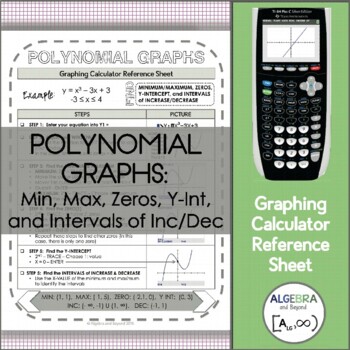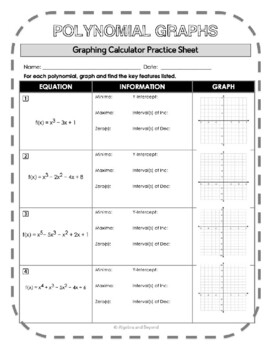Graphing Polynomial Graphs | TI-84 Calculator Reference Sheet and Practice
- PDF
- Google Apps™

What educators are saying
Also included in
- Build your students’ understanding of the TI-84 graphing calculator without repeating yourself over and over again - these graphing calculator reference sheets are step-by-step guides on how to use the TI-84 calculator for 40 different math topics in Algebra 1, Algebra 2, and Precalculus! Add thesePrice $45.00Original Price $75.00Save $30.00
Description
This graphing calculator reference sheet on polynomial graphs, guides students step-by-step on how to find the minimum, maximum, zeros, y-intercept, and intervals of increase and decrease for a polynomial function.
INCLUDED:
- Reference Sheet: A reference page with step-by-step instructions
- Practice Sheet: A practice page with four problems for students to review what they've learned.
- Digital Version: A Google Jamboard version is also included so students can practice these skills digitally.
Teaching graphing calculator skills help students with:
• Speed
• Making connections
• Checking for accuracy
• Leaping hurdles
*Reference sheet can be used with a TI-83 or TI-84 graphing calculator.
Please look at the preview to find out more information about this resource.
Check out more graphing calculator sheets here or get all of them...Graphing Calculator Reference Sheet - GROWING BUNDLE
∞∞∞∞∞∞∞∞∞∞∞∞∞∞∞∞∞∞∞∞∞∞∞∞∞∞∞∞∞∞∞∞∞∞∞∞∞∞∞∞∞∞∞∞∞∞∞
Learn more about Algebra and Beyond's resources:
• Website
© Algebra and Beyond 2016
This product is intended for personal use in one classroom only. For use in multiple classrooms, please purchase additional licenses.





